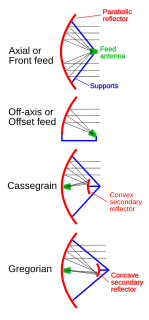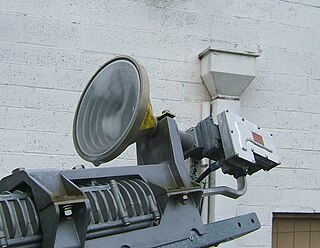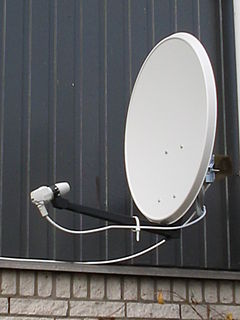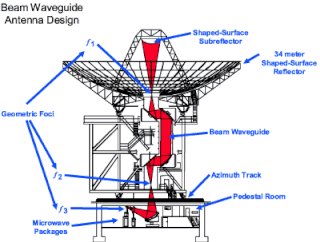
Microwaves are a form of electromagnetic radiation with wavelengths ranging from about one meter to one millimeter; with frequencies between 300 MHz (1 m) and 300 GHz (1 mm). Different sources define different frequency ranges as microwaves; the above broad definition includes both UHF and EHF bands. A more common definition in radio engineering is the range between 1 and 100 GHz. In all cases, microwaves include the entire SHF band at minimum. Frequencies in the microwave range are often referred to by their IEEE radar band designations: S, C, X, Ku, K, or Ka band, or by similar NATO or EU designations.

In telecommunications and radar, a Cassegrain antenna is a parabolic antenna in which the feed antenna is mounted at or behind the surface of the concave main parabolic reflector dish and is aimed at a smaller convex secondary reflector suspended in front of the primary reflector. The beam of radio waves from the feed illuminates the secondary reflector, which reflects it back to the main reflector dish, which reflects it forward again to form the desired beam. The Cassegrain design is widely used in parabolic antennas, particularly in large antennas such as those in satellite ground stations, radio telescopes, and communication satellites.

In parabolic antennas such as satellite dishes, a feed horn is a small horn antenna used to convey radio waves between the transmitter and/or receiver and the parabolic reflector. In transmitting antennas, it is connected to the transmitter and converts the radio frequency alternating current from the transmitter to radio waves and feeds them to the rest of the antenna, which focuses them into a beam. In receiving antennas, incoming radio waves are gathered and focused by the antenna's reflector on the feed horn, which converts them to a tiny radio frequency voltage which is amplified by the receiver. Feed horns are used mainly at microwave (SHF) and higher frequencies.

A parabolic reflector is a reflective surface used to collect or project energy such as light, sound, or radio waves. Its shape is part of a circular paraboloid, that is, the surface generated by a parabola revolving around its axis. The parabolic reflector transforms an incoming plane wave traveling along the axis into a spherical wave converging toward the focus. Conversely, a spherical wave generated by a point source placed in the focus is reflected into a plane wave propagating as a collimated beam along the axis.

A low-noise block downconverter (LNB) is the receiving device mounted on satellite dishes used for satellite TV reception, which collects the radio waves from the dish and converts them to a signal which is sent through a cable to the receiver inside the building. Also called a low-noise block, low-noise converter (LNC), or even low-noise downconverter (LND), the device is sometimes inaccurately called a low-noise amplifier (LNA).

The Holmdel Horn Antenna is a large microwave horn antenna that was used as a satellite communication antenna and radio telescope during the 1960s at Bell Telephone Laboratories in Holmdel Township, New Jersey, United States. It was designated a National Historic Landmark in 1988 because of its association with the research work of two radio astronomers, Arno Penzias and Robert Wilson. In 1965 while using this antenna, Penzias and Wilson discovered the cosmic microwave background radiation (CMBR) that permeates the universe. This was one of the most important discoveries in physical cosmology since Edwin Hubble demonstrated in the 1920s that the universe was expanding. It provided the evidence that confirmed George Gamow's and Georges Lemaître's "Big Bang" theory of the creation of the universe. This helped change the science of cosmology, the study of the history of the universe, from a field for unlimited theoretical speculation into a discipline of direct observation. In 1978 Penzias and Wilson received the Nobel Prize for Physics for their discovery.

A slotted waveguide is a waveguide that is used as an antenna in microwave radar applications. Prior to its use in surface search radar, such systems used a parabolic segment reflector. The slotted waveguide antenna was the result of collaborative radar research carried on by McGill University and the National Research Council of Canada during World War II. The co-inventors, W.H. Watson and E.W. Guptill of McGill, were granted a United States patent for the device, described as a "directive antenna for microwaves", in 1951.

A horn antenna or microwave horn is an antenna that consists of a flaring metal waveguide shaped like a horn to direct radio waves in a beam. Horns are widely used as antennas at UHF and microwave frequencies, above 300 MHz. They are used as feed antennas for larger antenna structures such as parabolic antennas, as standard calibration antennas to measure the gain of other antennas, and as directive antennas for such devices as radar guns, automatic door openers, and microwave radiometers. Their advantages are moderate directivity, low standing wave ratio (SWR), broad bandwidth, and simple construction and adjustment.

A microwave antenna is a physical transmission device used to broadcast microwave transmissions between two or more locations. In addition to broadcasting, antennas are also used in radar, radio astronomy and electronic warfare.

An orthomode transducer (OMT) is a waveguide component. It is commonly referred to as a polarisation duplexer. Orthomode transducers serve either to combine or to separate two orthogonally polarized microwave signal paths. One of the paths forms the uplink, which is transmitted over the same waveguide as the received signal path, or downlink path. Such a device may be part of a VSAT antenna feed or a terrestrial microwave radio feed; for example, OMTs are often used with a feed horn to isolate orthogonal polarizations of a signal and to transfer transmit and receive signals to different ports.

The Cassegrain reflector is a combination of a primary concave mirror and a secondary convex mirror, often used in optical telescopes and radio antennas, the main characteristic being that the optical path folds back onto itself, relative to the optical system's primary mirror entrance aperture. This design puts the focal point at a convenient location behind the primary mirror and the convex secondary adds a telephoto effect creating a much longer focal length in a mechanically short system.

An offset dish antenna or off-axis dish antenna is a type of parabolic antenna. It is so called because the antenna feed is offset to the side of the reflector, in contrast to the common "front-feed" parabolic antenna where the feed antenna is suspended in front of the dish, on its axis. As in a front-fed parabolic dish, the feed is located at the focal point of the reflector, but the reflector is an asymmetric segment of a paraboloid, so the focus is located to the side.

Microwave transmission is the transmission of information by microwave radio waves. Although an experimental 40-mile (64 km) microwave telecommunication link across the English Channel was demonstrated in 1931, the development of radar in World War II provided the technology for practical exploitation of microwave communication. In the 1950s, large transcontinental microwave relay networks, consisting of chains of repeater stations linked by line-of-sight beams of microwaves were built in Europe and America to relay long distance telephone traffic and television programs between cities. Communication satellites which transferred data between ground stations by microwaves took over much long distance traffic in the 1960s. In recent years, there has been an explosive increase in use of the microwave spectrum by new telecommunication technologies such as wireless networks, and direct-broadcast satellites which broadcast television and radio directly into consumers' homes.

A focal cloud is the collection of focal points of an imperfect lens or parabolic reflector whether optical, electrostatic or electromagnetic. This includes parabolic antennas and lens-type reflective antennas of all kinds. The effect is analogous to the circle of confusion in photography.

The Squarial is a satellite antenna used for reception of the now defunct British Satellite Broadcasting television service. The Squarial was a flat plate satellite antenna, built to be unobtrusive and unique. BSB were counting on the form factor of the antenna to clearly differentiate themselves from their competitors at the time. At the time of development, satellite installations usually required a 90 cm dish in order to receive a clear signal from the transmitting satellite. The smaller antenna was BSB's unique selling point and was heavily advertised in order to attract customers to their service.

A beam waveguide antenna is a particular type of large steerable parabolic antenna in which the radio waves are transported in a beam between the movable dish and the stationary transmitter or receiver using multiple reflective surfaces.
In radio systems, many different antenna types are used with specialized properties for particular applications. Antennas can be classified in various ways. The list below groups together antennas under common operating principles, following the way antennas are classified in many engineering textbooks.





















